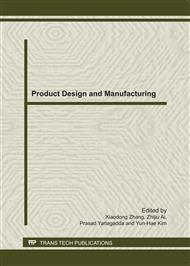p.193
p.199
p.205
p.209
p.214
p.223
p.227
p.231
p.236
Microwave Curing of Non-Traditional Polymer Materials Used in Manufacture of Injection Moulds
Abstract:
Microwave heating technology is a cost-effective alternative way for heating and curing of used in polymer processing of various alternate materials. The work presented in this paper addresses the attempts made by the authors to study the glass transition temperature and curing of materials such as casting resins R2512, R2515 and laminating resin GPR 2516 in combination with two hardeners ADH 2403 and ADH 2409. The magnetron microwave generator used in this research is operating at a frequency of 2.45 GHz with a hollow rectangular waveguide. During this investigation it has been noted that microwave heated mould materials resulted with higher glass transition temperatures and better microstructure. It also noted that Microwave curing resulted in a shorter curing time to reach the maximum percentage cure. From this study it can be concluded that microwave technology can be efficiently and effectively used to cure new generation alternate polymer materials for manufacture of injection moulds in a rapid and efficient manner. Microwave curing resulted in a shorter curing time to reach the maximum percentage cure.
Info:
Periodical:
Pages:
214-222
Citation:
Online since:
September 2011
Authors:
Price:
Сopyright:
© 2011 Trans Tech Publications Ltd. All Rights Reserved
Share:
Citation:


